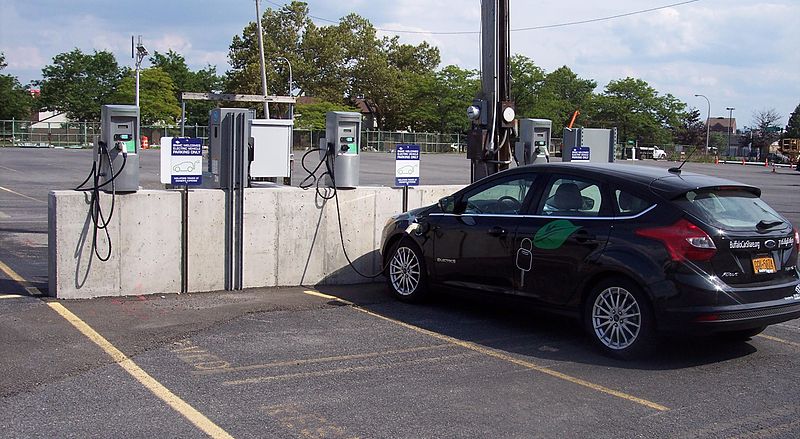The automotive industry’s capacity for innovation and marketing are on full display this month. Between the Consumer Electronic Show and the North American International Auto Show, every day brings a new story about the rapid development of vehicle technology. The industry possesses the know-how and ability to deliver on the zero-emissions future if it wants to.
Behind the headlines of engineering feats and product plans, though, is a disturbing fact. The industry is undermining its own innovation. It’s doing this through a campaign to dramatically weaken the central tool we have to move cleaner technology into the fleet – protective greenhouse gas reduction and fuel efficiency standards for new cars and passenger trucks.
Well-designed federal standards foster the deployment of fuel saving solutions. With the certainty of long-term standards in place, manufacturers are able to make the necessary investments to scale these solutions into the fleet. Scaled production further drives down costs, enhancing automaker profitability and consumer payback.
This cycle has been in full view over the past several years as automakers have brought to market ever more efficient vehicles with record sales and strong profitability. An exhaustive technical analysis completed by the U.S. Environmental Protection Agency, National Highway Traffic Safety Administration and California Air Resources Board found that automakers were well positioned to deliver even more fuel efficiency and emissions progress in the years ahead.
With this robust technical underpinning, the U.S. Environmental Protection Agency (EPA) issued a determination to maintain the existing 2022 to 2025 standards. Back in 2012, EPA finalized these standards with the broad support of the automotive industry. But fast forward to today, and the automotive industry is pushing for the Trump Administration to reconsider this determination.
This has set up a year of incongruity where the industry’s position that the standards need to be re-examined are consistently contradicted by its product announcements. In just this past year, automakers have made the following announcements:
- Daimler AG announced a billion dollar investment to build electric vehicles in the U.S. with production starting in the early 2020’s.
- BMW reached 100,000 in global electric vehicle sales while promising a dozen models of electric vehicles by 2025.
- Toyota committed to having at least 10 models of all-electric vehicles by the early 2020’s.
- Mazda promoted an engine breakthrough that could improve efficiency by up to 30 percent, and is planning to deploy the new engine in 2019.
- GM laid out a bold vision for a “zero crashes, zero emissions, and zero congestion” future, announced plans for 20 new electric vehicles by 2023 – including two by 2019, and rolled out the acclaimed Chevy Bolt across the U.S.
- Ford publicized its intention to have an electric vehicle with a range of 300 miles on the market by 2020.
These are not public announcements most automakers make lightly. They make them with high confidence in their ability to meet them.
As amazing as these announcements are, none of them are even necessary to meet the vehicle greenhouse gas standards that EPA finalized in 2012 and affirmed last year. The industry is already poised to meet these standards with broader adoption of more conventional technologies.
The impressive innovation in advanced engine design and electrification – which the industry clearly believes will start to scale over the next few years – will make the standards even more attainable.
Yet, despite the remarkable recent record of innovation and the significant investments made in developing a new generation of clean vehicle solutions, the automotive industry – through its trade associations – has chosen a path to weaken our existing emissions standards and has stayed silent as EPA Administrator Scott Pruitt has threatened California’s own protective vehicle emission standards.
The industry’s actions are contradictory and concerning. Yet, there is still time for automakers to choose a different path – one that looks to the future and seeks to build a new round of protective standards that rewards the industry’s innovation, lowers costs for families and protects human health and the environment.
As the announcements are made over the coming days, we should also be listening to hear if any automakers are willing to match their record on innovation with what the industry most needs now – leadership.











One Comment
Jason, again and again EDF offers a prescription for a “zero-emission future” which guarantees reliance on fossil fuels indefinitely.
The 1996 introduction of General Motors’ EV1 was a wakeup call for the oil industry. The car’s technical success made it clear the future of gasoline was limited – that electric vehicles customers could plug into the wall were the future of U.S. consumer transportation.
Recognizing an existential threat to their core product, oil companies took action. With the American Petroleum Institute (API) as their mouthpiece, they promoted hydrogen fuel cell vehicles dependent on methane production for fuel, and promoted methane to generate the electricity EV owners would use to charge their cars. They attacked nuclear energy, running anti-nuclear print ads, lobbying for utility deregulation, and expanded domestic natural gas production. By replacing nuclear with methane to generate electricity, API knew their members’ profit streams were guaranteed.
Most insidious was the financing of pseudo-environmental organizations “Natural Resources Defense Council”, “Friends of the Earth”, “Sierra Club”, and your own “Environmental Defense Fund”, by forking over $millions in funding for natural gas “research”. Did it amount to paid promotion? Quid pro quo? Possibly no one but Fred Krupp knows for sure, but at the very least it could be considered “Quid-pro-conflict-of-interest”, couldn’t it?